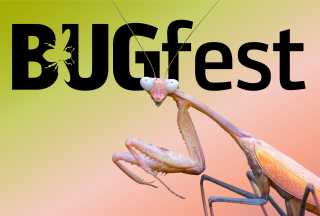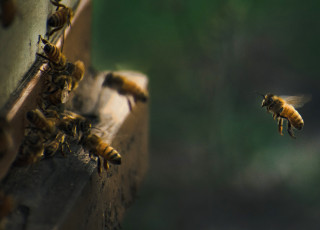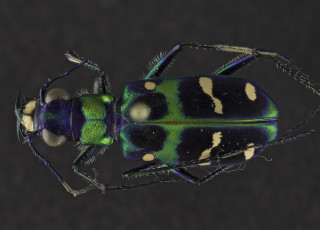Learning To Love Bugs? You Need To Visit Bugfest
Enjoy this article and don't forget that BugFest returns to NHMU on August 9–10, 2025! Come join us for this BIG celebration of Utah’s tiniest residents.
By Jude Coleman
It’s easy to lump insects into ‘good’ and ‘bad’ categories. After all, some of the ‘bad’ ones are well-known: bugs that bite us and potentially spread disease can be annoying, dangerous, and sometimes deadly. But the vast majority of insects don’t have “harm humans” anywhere on their to-do list. In fact, insects are essential to life on Earth. Even the creepiest of the crawlies have an important niche to fill. Without insects, scientists estimate that much of life on Earth would screech to a halt in a few months.

“We may not entirely know what roles some species play, but they're in their abundance for a reason,” said entomologist Jason Cryan, The Sarah B. George Executive Director at the Natural History Museum of Utah. That’s one reason entomologists are calling for a shift in public perception of insects. “Good” versus “bad” labels often center on humans’ needs or desires, but there is more to the story than that.
To celebrate insects and their importance to the planet, NHMU is holding its popular BugFest event again this summer. Visitors can explore Utah’s diverse insects and their unique roles at the museum on August 9-10, with a special, film screening kickoff event on the evening of Friday, August 8.
Insects: The Tiny Heroes That Keep Our World in Balance

One obvious benefit of insects is that they pollinate plants. But it’s not just bumblebees and butterflies that get that credit. Thousands of species of flies, beetles, wasps and moths are also pollinators. Together, insects are responsible for pollinating around a third of all food crops, on top of flowers and other plants. Predatory insects also aid plants by keeping herbivores such as aphids in check. Herbivores and omnivores alike feed animals higher up on the food chain too, including birds, fish, reptiles and even mammals. Insects are such a vital food source, in fact, that recent reductions in insect numbers are correlated with declining bird populations. Researchers have found that despite their ubiquity, insect species and biomass have sharply declined in the last century or so. “We can anticipate nothing good coming from this dramatic, significant reduction,” said Cryan.
Insects are also valuable decomposers, working with microbes to break down animal poop and dead organic matter. Cockroaches, for example, aren’t highly favored by folks, said Christy Bills, the Invertebrates Collection Manager at NHMU. Yet the seemingly invincible critters help to break down plant matter and return nutrients back to the soil. The Australian Dung Beetle project is a prime example of insects’ waste management role. When cattle were first brought to Australia in the late 1700s, the native dung beetles quickly became overwhelmed with cow pies. Because cattle didn’t exist on the continent, the native beetles weren’t adapted to clean up cow dung. A few centuries later, entomologists brought dung beetles from other parts of the world to Australia—and 200 years of cow patties began to disappear.

David Cappaert, Bugwood.org
While the Australian Dung Beetle Project was a success, not all human-related insect relocations turn out positively, said Bills. “I call these BOOPs: Bugs Out Of Place,” she said. These BOOPs are an example of when ascribing positive or negative to insects becomes complicated. Insects introduced to new environments can wreak havoc on ecosystems, becoming pests, while in their native environs they are held in check by their natural predators, parasites, and other factors. For example, the emerald ash borer—native to Asia—hitched a ride in shipping crates from Asia to North America in the 1990s. In their new environment, they attack healthy ash trees that are different species than what they evolved with. In its home range, the ash tree species that the beetles inhabit have evolved special defenses against the beetle, and thus the beetles attack only dead or dying trees in the area. But to the different species of ash trees in North America, the ash borer has become a huge concern, killing millions of ash trees.
Even still, Bills points out, insects that cause economic and environmental loss like the emerald ash borer are few and far between. “It’s not for us to assign good or bad based on how an insect behaves and how it affects us,” she said. And even with most insects in their proper habitats, filling the roles they have evolved for, what humans consider to be good or bad doesn’t reflect what’s best or natural for an ecosystem, pointed out Cryan. “The answer is much more complex and nuanced.”

The first step of shifting public perceptions about insects is through education, said Bills and Cryan. Understanding insect behavior is a big part of that. For instance, wasps tend to fall on people’s bad list, given that some can cause painful stings. Not all wasps sting, though—in fact, the majority won’t sting a human. Similarly, bees would rather not sting: doing so kills the bee. And spiders (which technically aren’t insects, but rather arachnids), tend to only bite if they’re threatened. Typically, insects want nothing to do with humans. To avoid negative interactions with them, Bills and Cryan said to remain calm and move away from the insect. Panicking and swatting boosts the likelihood that a sting or bite could happen. But still, there’s a time and place for protecting human health and property. Mosquito spray and netting, for example, are important and effective tools.
Other than learning about insects, simply observing them can go a long way toward acceptance, said Bills. Take a moment to marvel at ants’ superior strength or admire the iridescence of a fly. “You can't love something unless you understand it,” said Cryan. “And you can't understand it unless you learn about it.”

BugFest Returns to NHMU!
Flutter on up to BugFest — a BIG celebration of Utah’s tiniest residents. Join us August 9-10, with a special film screening on Friday, August 8.




